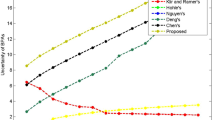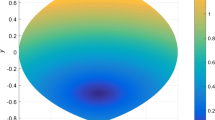Abstract
Assignment of confidence mass appropriately is still an open issue in information fusion. The most popular rule of combination, Dempster’s rule of combination, has been widely used in various fields. In this paper, a belief interval negation is proposed based on belief interval. The belief interval has a stronger ability to express basic probability assignment (BPA) uncertainty. By establishing belief interval in an exhaustive frame of discernment (FOD), the negation is obtained in the form of a new interval. Belief interval negation as an essential tool for measuring uncertainty builds the relationship among BPA, belief interval and entropy. Furthermore, the new negation is applicable to various belief entropies and entropy increment is verified in negation iterations. Two novel uncertainty measures proposed in this paper are applicable to the newly proposed belief interval negation, too. Finally, convergent mass distribution is discussed. Some numerical examples and its application in medical pattern recognition are exhibited.































Similar content being viewed by others
References
Liu Z, Pan Q, Dezert J, Han J-W, He Y (2018) Classifier fusion with contextual reliability evaluation. IEEE Trans Cybern 48(5):1605–1618
Fan C-, Song Y, Fu Q, Lei L, Wang X (2018) New operators for aggregating intuitionistic fuzzy information with their application in decision making. IEEE Access 6:27214–27238
Seiti H, Hafezalkotob A (2018) Developing pessimistic–optimistic risk-based methods for multi-sensor fusion: An interval-valued evidence theory approach. Appl Soft Comput 72:609–623
Xu X, Li S, Song X, Wen C, Xu D (2016) The optimal design of industrial alarm systems based on evidence theory. Control Eng Pract 46:142–156
Zhou M, Liu X-B, Chen Y-W, Yang J-B (2018) Evidential reasoning rule for MADM with both weights and reliabilities in group decision making. Knowl-Based Syst 143:142–161
Liu Z-G, Pan Q, Dezert J, Martin A (2018) Combination of classifiers with optimal weight based on evidential reasoning. IEEE Trans Fuzzy Syst 26(3):1217–1230
Liu Q, Tian Y, Kang B (2019) Derive knowledge of z-number from the perspective of dempster-shafer evidence theory. Eng Appl Artif Intell 85:754–764
Fei L (2019) On interval-valued fuzzy decision-making using soft likelihood functions. Int J Intell Syst 34:1631–1652
Fei L, Xia J, Feng Y, Liu L (2019) An ELECTRE-based multiple criteria decision making method for supplier selection using Dempster-Shafer theory. IEEE Access 7:84701–84716
Seiti H, Hafezalkotob A, Najaf S E (2019) Developing a novel risk-based MCDM approach based on D numbers and fuzzy information axiom and its applications in preventive maintenance planning. Appl Soft Comput J 82. https://doi.org/10.1016/j.asoc.2019.105559https://doi.org/10.1016/j.asoc.2019.105559
Jiang W, Cao Y, Deng X (2019) A novel z-network model based on bayesian network and z-number. IEEE Trans Fuzzy Syst 28:1585–1599
Srivastava A, Maheshwari S (2018) Some New Properties of Negation of a Probability Distribution. Int J Intell Syst 33(6):1133–1145
Yager R R (2015) On the maximum entropy negation of a probability distribution. IEEE Trans Fuzzy Syst 23(5):1899–1902
Gao X, Deng Y (2019) The Negation of Basic Probability Assignment. IEEE Access 7:107006–107014
Lefevre E, Colot O, Vannoorenberghe P (2002) Belief function combination and conflict management. Inf Fusion 3(2):149–162
Luo Z, Deng Y (2020) A matrix method of basic belief assignment’s negation in dempster-shafer theory. IEEE Trans Fuzzy Syst 28:2270–2276
Yager R R (2012) Entailment principle for measure-based uncertainty. IEEE Trans Fuzzy Syst 20(3):526–535
Zhou M, Liu X-B, Chen Y-W, Qian X-F, Yang J-B, Wu J (2019) Assignment of attribute weights with belief distributions for MADM under uncertainties. Knowl-Based Syst 189 https://doi.org/10.1016/j.knosys.2019.105110
Deng Y (2020) Uncertainty measure in evidence theory. Sci China Inf Sci 63(11):210201
Deng X, Jiang W (2019) A total uncertainty measure for D numbers based on belief intervals. Int J Intell Syst 34(12):3302–3316
Yager R R (2018) Interval valued entropies for Dempster-Shafer structures. Knowl-Based Syst 161:390–397
Yager R R (2018) On using the Shapley value to approximate the Choquet integral in cases of uncertain arguments. IEEE Trans Fuzzy Syst 26(3):1303–1310
Liao H, Mi X, Xu Z (2019) A survey of decision-making methods with probabilistic linguistic information: Bibliometrics, preliminaries, methodologies, applications and future directions. Fuzzy Optim Decis Making 19:81–134
Fang R, Liao H, Yang J-B, Xu D-L (2019) Generalised probabilistic linguistic evidential reasoning approach for multi-criteria decision-making under uncertainty. J Oper Res Soc 72:130–144
Zhou M, Liu X, Yang J (2017) Evidential reasoning approach for MADM based on incomplete interval value. J Intell Fuzzy Syst 33(6):3707–3721
Feng F, Liang M, Fujita H, Yager R R, Liu X (2019) Lexicographic orders of intuitionistic fuzzy values and their relationships. Mathematics 7(2):1–26
Cheng C, Xiao F, Pedrycz W (2020) A majority rule-based measure for atanassov type intuitionistic membership grades in mcdm. IEEE Trans Fuzzy Syst PP
Xu X, Xu H, Wen C, Li J, Hou P, Zhang J (2018) A belief rule-based evidence updating method for industrial alarm system design. Control Eng Pract 81:73–84
Xu X-B, Ma X, Wen C-L, Huang D-R, Li J-N (2018) Self-tuning method of PID parameters based on belief rule base inference. Inf Technol Control 47(3):551–563
Song Y, Fu Q, Wang Y-F, Wang X (2019) Divergence-based cross entropy and uncertainty measures of Atanassov’s intuitionistic fuzzy sets with their application in decision making. Appl Soft Comput 84. https://doi.org/10.1016/j.asoc.2019.105703
Dempster A P (2008) Upper and lower probabilities induced by a multivalued mapping. Springer
Shafer G (1976) A mathematical theory of evidence. Princeton University Press
Yager R R (2019) Generalized Dempster–Shafer structures. IEEE Trans Fuzzy Syst 27(3):428–435
Yager R R (2019) Entailment for measure based belief structures. Inf Fusion 47:111–116
Xiao F, Cao Z, Jolfaei A (2020) A novel conflict measurement in decision making and its application in fault diagnosis. IEEE Trans Fuzzy Syst PP:1–1
Liu Z, Liu Y, Dezert J, Cuzzolin F (2019) Evidence combination based on credal belief redistribution for pattern classification. IEEE Trans Fuzzy Syst 28:618–631
Ma J, Yu W, Liang P, Li C, Jiang J (2019) Fusiongan: A generative adversarial network for infrared and visible image fusion. Inf Fusion 48:11–26
Wang Q, Li Y, Liu X (2018) The influence of photo elements on EEG signal recognition. EURASIP J Image Video Process 2018(1):134
Cao Z, Ding W, Wang Y-K, Hussain F K, Al-Jumaily A, Lin C-T (2019) Effects of repetitive SSVEPs on EEG complexity using multiscale inherent fuzzy entropy. Neurocomputing 389:198–206
Zhang H, Deng Y (2021) Entropy Measure for Orderable Sets. Inf Sci 561:141–151
Raghavendra U, Fujita H, Bhandary S V, Gudigar A, Hong Tan J, Acharya U R (2018) Deep convolution neural network for accurate diagnosis of glaucoma using digital fundus images. Inf Sci 441:41–49
Acharya U R, Fujita H, Oh S L, Hagiwara Y, Tan J H, Adam M, Tan R S (2019) Deep convolutional neural network for the automated diagnosis of congestive heart failure using ecg signals. Appl Intell 49:16–27
Yin L, Deng X, Deng Y (2019) The negation of a basic probability assignment. IEEE Trans Fuzzy Syst 27:135–143
Xie K, Xiao F (2019) Negation of Belief Function Based on the Total Uncertainty Measure. Entropy 21(1)
Cao Z, Lin C-T, Lai K-L, Ko L-W, King J-T, Liao K-K, Fuh J-L, Wang S-J (2019) Extraction of SSVEPs-based Inherent fuzzy entropy using a wearable headband EEG in migraine patients. IEEE Trans Fuzzy Syst 28:14–27
Zhou D, Al-Durra A, Zhang K, Ravey A, Gao F (2019) A robust prognostic indicator for renewable energy technologies: A novel error correction grey prediction model. IEEE Trans Ind Electron 66(12):9312–9325
Son L H, Fujita H (2019) Neural-fuzzy with representative sets for prediction of student performance. Appl Intell 49:172–187
Xiao F (2019) Distance measure of intuitionistic fuzzy sets and its application in pattern classification. IEEE Transactions on Systems, Man, and Cybernetics: System. In press
Xu X, Zheng J, Yang J-, Xu D-, Chen Y- (2017) Data classification using evidence reasoning rule. Knowl-Based Syst 116:144–151
Liu Z-G, Pan Q, Dezert J, Mercier G (2017) Hybrid classification system for uncertain data. IEEE Trans Syst Man Cybern Syst 47(10):2783–2790
Fujita H, Gaeta A, Loia V, Orciuoli F (2019) Improving awareness in early stages of security analysis: A zone partition method based on grc. Appl Intell 49:1063–1077
Liu Z, Xiao F, Lin C-T, Kang B, Cao Z (2019) A generalized golden rule representative value for multiple-criteria decision analysis. IEEE Trans Syst Man Cybern Syst PP:1–12
Xiao F (2020) EFMCDM: Evidential fuzzy multicriteria decision making based on belief entropy. IEEE Trans Fuzzy Syst 28:1477–1491
Shannon C E (1948) A mathematical theory of communication. Bell Syst Techn J 27(3):379–423
Srivastava A, Kaur L (2019) Uncertainty and negation-information theoretic applications. Int J Intell Syst 34(6):1248–1260
Deng J, Deng Y (2021) Information volume of fuzzy membership function. Int J Comput Commun Control 16(1):4106
Deng Y (2020) Information volume of mass function. Int J Comput Commun Control 15(6):3983
Maeda Y, Nguyen H T, Ichihashi H (1993) Maximum entropy algorighms for uncertainty measures. Int J Uncertain Fuzz Knowl-Based Syst 01(01):69–93
Höhle U (1982) Entropy with respect to plausibility measures. Proceedings of the 12th IEEE Symposium on Multiple-Valued Logic, pp 167–169
Yager RR (1983) Entropy and specificity in a mathematical theory of evidence. Int J Gen Syst 9(4):249–260
Pan L, Deng Y (2020) Probability transform based on the ordered weighted averaging and entropy difference. Int J Comput Commun Control 15(4):3743
Acknowledgements
The work is partially supported by National Natural Science Foundation of China (Grant No. 61973332), JSPS Invitational Fellowships for Research in Japan (Short-term).
Author information
Authors and Affiliations
Contributions
Writing-original draft, H.M.;Writing-review & editing, H.M. and Y.D.
Corresponding author
Ethics declarations
Competing interests
The authors declare that there is no conflict of interests regarding the publication of this paper.
Additional information
Publisher’s note
Springer Nature remains neutral with regard to jurisdictional claims in published maps and institutional affiliations.
Rights and permissions
About this article
Cite this article
Mao, H., Deng, Y. Negation of BPA: a belief interval approach and its application in medical pattern recognition. Appl Intell 52, 4226–4243 (2022). https://doi.org/10.1007/s10489-021-02641-7
Accepted:
Published:
Issue Date:
DOI: https://doi.org/10.1007/s10489-021-02641-7




